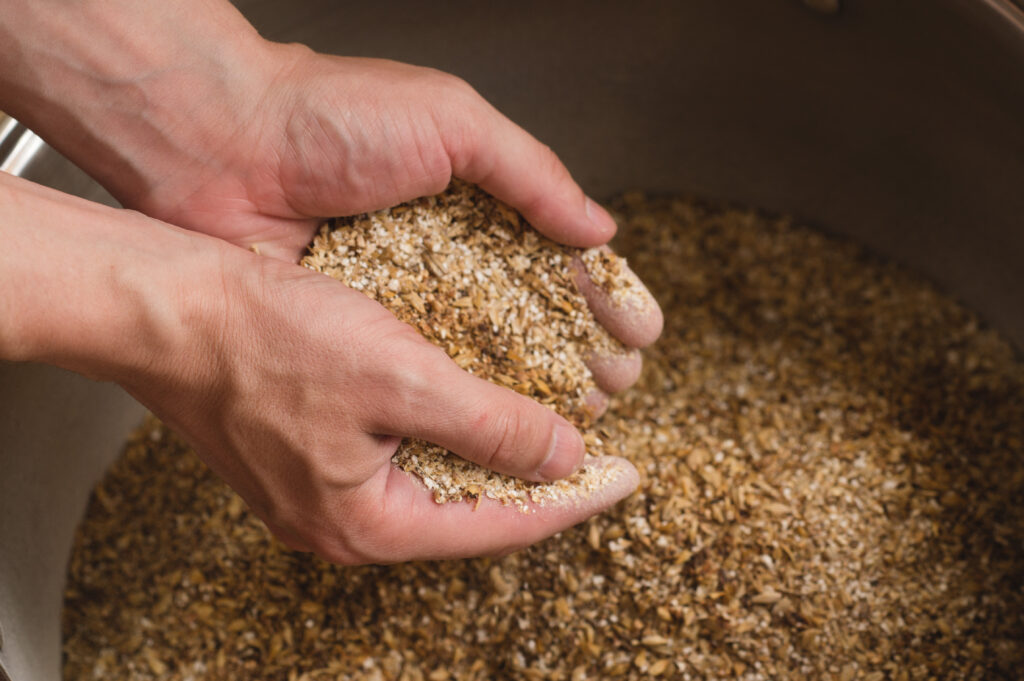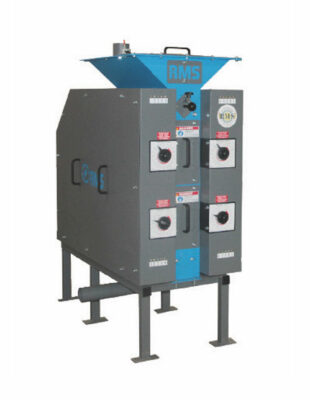A Quick Overview of Distilling Grain
To begin, note that the distillation process of alcoholic beverages, particularly whiskies, mainly uses two methods: On Grain vs Off Grain Distillation.
’’Grain in or also called ’in the grain’ is basically where you are just completely passing your mash through ’’with the grain in’’ to fermentation. Meanwhile, grain out or ’off the grain’ is when you’re lautering or separating out your wort from your spent grain before you pass it along.
And so some of the benefits of a grain in fermentation, it’s going to be more efficient and you’re going to get as much utilization of that grain as you possibly can. So you’re going to get the most kind of out of your money for that grain. So the big pro for grain out is that it’s a lot easier for pumping, for handling. And then some will say that you get a little cleaner flavor when you do it.’’
– Riley Aadland, RMS Roller Grinder Applications Engineer
 Understanding the difference between On Grain vs Off Grain distillation is crucial as it significantly impacts the flavor and character of the final product.
Understanding the difference between On Grain vs Off Grain distillation is crucial as it significantly impacts the flavor and character of the final product.
Distillers must carefully choose the appropriate method based on the desired flavor profile and style they aim to achieve.
Factors such as the choice of grains, yeast strains, fermentation process, and the use of oak barrels all play a role in the distillation process, and contribute to the alcohol content and flavor complexity of the finished spirits.
The careful consideration of distillation methods can lead to the production of high-quality and unique grain whiskies that cater to various consumer preferences.
What Does “Grain In” Particle Size Even Look Like
For distillers who do opt for using the “grain in” method for distillation, the “particle size” becomes much more important. The “grain in” particle size refers to the size of the grains used in the mashing process before distillation.
’’In grain out, we need our grains to be a little bit coarser so we can get the wort separated from that spent grain. So the average particle size that we typically see on a grain out fermentation application is somewhere between 1,200 – 1500 microns.
For grain in, however, we want to make it a little finer. And then that allows us to increase the surface area of those particles so we can pull out as much sugar out of the grain as much as possible. So the particle size that we typically see our customers target is in the 400 to 500 micron range.’’
– Riley Aadland, RMS Roller Grinder Applications Engineer
 These grains, such as malted barley, also play a significant role in the flavor and character of the final product.
These grains, such as malted barley, also play a significant role in the flavor and character of the final product.
The size of the grain particles can greatly impact the efficiency of the mashing process, and the extraction of flavors during distillation.
Distillers often face challenges when working with different source flours, as they may have different particle sizes.
Distillers should carefully consider the particle size of their grains and the method they use to grind their grain to ensure a balanced, flavorful, and consistent end product.
The size of the grains can influence the efficiency of the mashing process, the flavors extracted during fermentation, and ultimately, the quality of the distilled spirits.
Pros & Cons of a Hammer Mill vs. Roller Mill
When it comes to the grinding process for grains, distillers have two main options: using a hammer mill or a roller mill. Each method has its pros and cons, and understanding the differences can help distillers make the best choice for their specific needs.
A hammer mill is a high-speed machine that uses hammers and screens to break down grain particles. It is known for producing fine powder compared to a roller mill. The finely ground powder obtained from a hammer mill can lead to a smoother and more refined spirit.
 On the other hand, a roller mill uses rollers to crush and grind grain into a coarser grind .
On the other hand, a roller mill uses rollers to crush and grind grain into a coarser grind .
This method typically produces a coarser grind size than hammer mills, leading to a more textured and full-bodied spirit, which some distillers may prefer for certain types of whiskey or bourbon.
One potential disadvantage of using a hammer mill is the increased energy usage compared to a roller mill. Hammer mills tend to require more power to operate, which can result in higher energy costs for distilleries. Additionally, the vibration caused by the hammers pounding on the grain may lead to more wear and tear on the equipment.
’’One pro of the hammer mill is that it is a very simple piece of equipment. It’s easy to set up, easy to use and it’s effective if you want to mill very, very fine grain. However, some of the drawbacks are the maintenance that comes with it,
You have a lot more wear on parts, it creates a lot more dust and you may need a dust collector or an air assist to get the hammer mill to work properly. A lot of times, it’s going to require a very large horsepower motor…so it’s not quite as energy efficient as say a roller mill.’’
– Riley Aadland, RMS Roller Grinder Applications Engineer
In contrast, roller mills are generally more efficient and require less energy to operate. They also have a smaller footprint, making them a preferable choice for distilleries with limited space. Roller mills also offer greater control over the grinding process, allowing distillers to achieve a specific particle size range with accuracy.
About RMS Roller Grinder
If you have questions about understanding particle size for distilling grain, feel free to contact us anytime.
RMS Roller-Grinder builds and services the best roller mills and accessories for all our customers’ unique grinding applications.
If you need a consultation on an existing machine or installing a new one, we can partner with you to ensure you receive the most efficient and most reliable products and support.
Our goal is to leave you with peace of mind by doing whatever it takes to remove troubles and frustration from your entire system.
